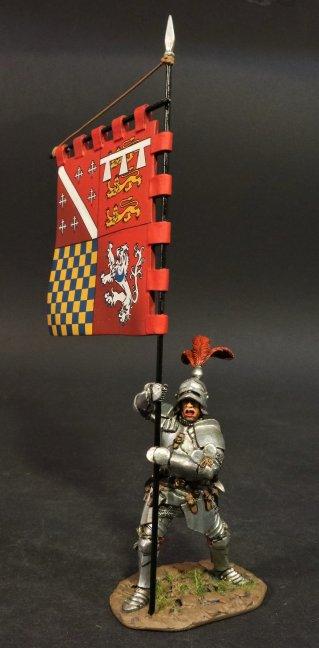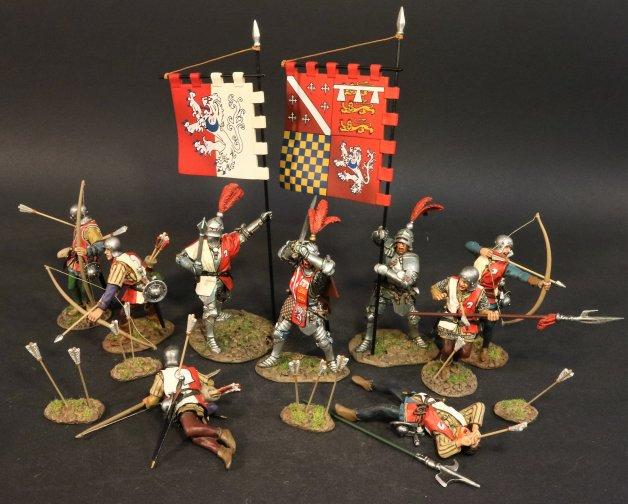Standard Bearer, The Retinue of Sir Thomas Howard of Ashwell Thorpe, Earl of Surrey, The Battle of Bosworth Field, 1485, The Wars of the Roses, 1455-1487—single figure and standard
$69.00
Item Number: THYORK-02
Standard Bearer, The Retinue of Sir Thomas Howard of Ashwell Thorpe, Earl of Surrey, The Battle of Bosworth Field, 1485, The Wars of the Roses, 1455-1487
Thomas Howard was an English nobleman, soldier, and statesman who served four monarchs. He was the eldest son of John Howard, 1st Duke of Norfolk, by his first wife Catharina de Moleyns. The Duke was the grandfather of both Queen Catherine Howard and the great grandfather of Queen Elizabeth I.
In 1513, he led the English to victory over the Scots at the decisive Battle of Flodden, for which he was richly rewarded by King Henry VIII, who was away in France at the time.
THE WARS OF THE ROSES 1455-1487
The Wars of the Roses were a series of dynastic wars for the throne of England. They were fought between supporters of two rival branches of the royal House of Plantagenet: the houses of Lancaster and York. They were fought in several sporadic episodes between 1455 and 1487, although there was related fighting before and after this period. The conflict resulted from social and financial troubles that followed the Hundred Years' War, combined with the mental infirmity and weak rule of Henry VI, which revived interest in the alternative claim to the throne of Richard, Duke of York. The final victory went to a claimant of the Lancastrian party, Henry Tudor, who defeated the last Yorkist king, Richard III, at the Battle of Bosworth Field. After assuming the throne as Henry VII, Henry Tudor married Elizabeth of York, the eldest daughter and heiress of Edward IV, thereby uniting the two claims. The House of Tudor ruled England and Wales until 1603.
THE BATTLE OF BOSWORTH FIELD 1485
The Battle of Bosworth (or Bosworth Field) was the last significant battle of the Wars of the Roses, the civil war between the Houses of Lancaster and York that raged across England in the latter half of the 15th century. Fought on 22 August 1485, the battle was won by the Lancastrians. Their leader Henry Tudor, Earl of Richmond, by his victory became the first English monarch of the Tudor dynasty. His opponent, Richard III, the last king of the House of York, was killed in the battle. Historians consider Bosworth Field to mark the end of the Plantagenet dynasty, making it a defining moment of English and Welsh history.
LIVERIES AND BADGES
By the time of the Wars Of The Roses, badges were of considerable importance. These along with the Livery Colours were closely associated with what was then known as Livery and Retaining (Bastard Feudalism). The badges were rarely worn by their owners, for they were marks of ownership. They were, however, worn by his servants, house-hold men, retainers, and probably, temporarily, by the adherents to his cause. So great and extensive was the use of these badges, that they were far more generally employed than the coat of arms. For where a man’s badge would be common knowledge and bear some repute throughout the kingdom, few people would know what his coat of arms looked like.
HERALDIC BANNERS, BANNERS AND STANDARDS
There were three main types of flags used during the Wars of The Roses.
The largest was known as the Heraldic Banner, and was used solely for displaying the coats of arms. This was normally square and made with stiffened buckram with a batton along the top. Therefore, it was always on the fly, so the standard bearer did not have to wave the banner about, which gave him a spare hand in which he could brandish a weapon, so he would be able to defend himself and the banner.
The Banner was a smaller version of the Heraldic Banner, and usually only carried one large badge or device. The field was often in the colour of the livery, but this was not a rule.
The third type was known as a standard, and was a long swallow tailed style.
In an effort to destroy Henry Tudor, Richard decided to leave his position on Ambion Hill, leading his household retainers down the slope, thundering towards Henry’s men with levelled lances. King Richard III and his standard bearer, Sir Percival Thirlwall, charged towards Henry Tudor and his standard bearer William Brandon. Richard had seen Henry separated from his main force during the battle, and decided to end the fight quickly by killing the enemy commander. He led the charge of mounted knights into Henry’s small group of men.
Oxford had left a small reserve of pike equipped mercenaries with Henry, which proved critical in slowing down the pace of the charging knights. Although the initial charge had seen Richard kill Sir William Brandon, Henry’s Standard bearer, the remainder of Henry’s bodyguards and mercenary pikemen succeeded in delaying the Yorkist attack. Seeing Richard embroiled with Henry’s men, and separated from his main force, William Stanley made a decision to ride to the aid of Henry. Now outnumbered, the Yorkist group was surrounded and gradually driven back, where “King Richard, alone, was killed fighting manfully in the thickest press of his enemies”.
King Richard III (2 October 1452 – 22 August 1485) was King of England from 1483 until his death in 1485, at the age of 32, in the Battle of Bosworth Field. He was the last king of the House of York and the last of the Plantagenet dynasty. His defeat at Bosworth Field, the last decisive battle of the Wars of the Roses, marked the end of the Middle Ages in England.
Released in DECEMBER 2021.

